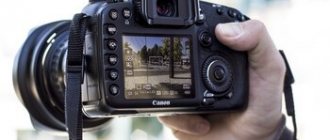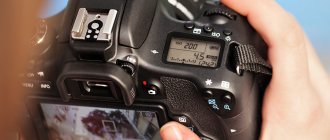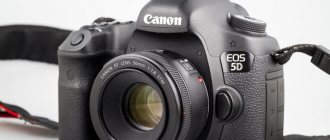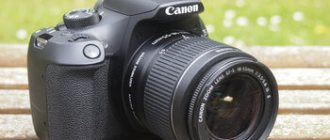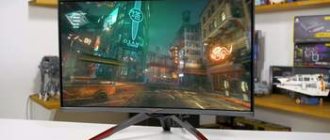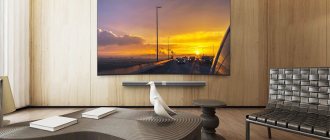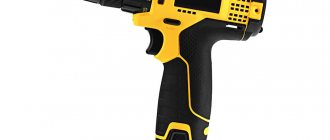Professional photographers with many years of experience can easily choose camera, meeting your requirements.
For example, a device for studio or street photography, for natural landscapes or portrait shots - all this must be taken into account.
But those who are just learning the world of professional photography still have to choose an assistant for all filming occasions.
How not to get confused and make a mistake with a purchase?
Rating of the TOP 10 best professional cameras
| Place | Model | Price |
| Middle segment | ||
| #1 | Nikon D780 Body | |
| #2 | Canon EOS 6D Body | |
| #3 | Nikon D610 Body | |
| #4 | Canon EOS 6D Mark II Body | |
| #5 | Nikon D750 Body | |
| Premium segment | ||
| #1 | Pentax K-1 Mark II Body | |
| #2 | Canon EOS 1D X Mark III Body | |
| #3 | Nikon D850 Body | |
| #4 | Canon EOS 5D Mark IV Body | |
| #5 | Pentax K-1 Body | |
Page navigation:
How to choose a DSLR camera
Wedding photographer Adelina Minibaeva explains that from the very beginning you need to understand why you need a camera. It is unreasonable to expect good and sharp night shots from a starter kit for 30 thousand rubles.
Full-frame and cropped cameras
To simplify everything completely, the main content of a SLR camera is a matrix that records the light falling on it through the lens. Matrices are divided into two types - full-frame (CMOS matrices) and “cropped” (from the English verb to crop) APC-C matrices. In cheaper models, to save money, they use a smaller matrix, which will contain less images. Accordingly, because of this, the detail of the frame suffers - colors and their shades are lost, especially in low light.
DSLR camera life
As we have already said, the matrix is one of the most important parts of a modern camera. In SLR cameras, it works in conjunction with a mechanical shutter, which raises and lowers the very “mirror” that reflects the image onto the matrix when you press the shutter. Of course, the lifespan of such a mechanism is limited - after a while it simply breaks down.
A modern amateur camera costing 50 thousand rubles will withstand no more than 30-40 thousand shutter releases. A semi-professional camera costing up to 70-80 thousand rubles will, at best, handle up to 100 thousand mirror lifts.
Professional cameras costing 100 thousand rubles or more are the most durable. Their shutter mechanism will withstand up to 500 thousand cycles of raising the mirror inside the camera.
An inexpensive “kit” camera is suitable for an amateur
In most cases, a “cropped” camera is also suitable for amateur photographers; it is not always worth falling for the tricks of marketers - on social networks or instant messengers you are unlikely to notice the difference in the quality of pictures taken under standard conditions on camera sets for 30 and 200 thousand rubles. Much depends on the ability to set up the camera and frame composition.
The DSLR market is currently going through some tough times. More and more photographers are switching to lightweight and compact mirrorless systems from Sony, Nikon or Canon. However, we have compiled a list of DSLR + lens kits that are most relevant in 2021.
What to look for when choosing a professional camera?
A professional camera is not a cheap device , so its purchase should be more than conscious.
Important! A good camera does not cause any problems or inconveniences for the photographer, and pleases clients with high-quality and bright photographs.
What characteristics should be taken into account when purchasing a professional camera?:
- Ease of use of the device. Everything is important here - from the dimensions and weight to the location of the shutter button and the possibility of attaching to a tripod. Shooting (for example, wedding) can take the whole day. Therefore, the photographer should enjoy long-term communication with the device.
- Autonomy. All for the same reason - the duration of the photo shoot - it is very important that the camera holds a good charge or has several removable batteries so that you can quickly return it to work.
- Ease of Management. For some photographers, the ability to quickly switch between modes is important. For example, if the shooting takes place outdoors, where the weather can suddenly change from clear to cloudy, you need to change the lighting settings.
- Memory size. In most cases, professional equipment has a reserve of built-in memory. But what is much more important is the maximum memory card capacity it supports. Professionals, as a rule, cannot get by with household 32 or 64 GB.
- Image quality. Professionals are expected to take pictures that will be many times better in quality than photos taken on a smartphone. The most important matrix parameters here are the number of megapixels.
- Flash sync speed. For professional devices, the figure should be at least 1/250 or 1/500, ideally 1/1–000.
- RAW mode. In this case, photos are saved on the camera in the form in which they were created. This means much more editing possibilities: “raw” images convey more information.
- Possibility of video recording and its quality. It is better if the saved videos have a resolution no worse than Full HD.
- Noise level and light sensitivity. This parameter is indicated in the data sheet as ISO. The higher the number, the better.
- Display. A large, rich display with a rotating mechanism makes shooting as comfortable as possible.
- Protection of the case from shock, moisture and dust, reliable design.
How is it different from other camera models?
Professional cameras have unique capabilities. For such features you have to shell out a tidy sum of money. As a rule, this is 3-4, sometimes 10 times more than a regular amateur camera. Everyone has their own need. For some, a full-frame sensor is important, for others - flash speed, for others - a solid appearance.
As a rule, professional equipment will have a higher matrix. She is responsible for image quality. Experienced photographers recommend choosing Full frame, APS-C or Micro 4/3, not lower than this level. Professional cameras will have less digital noise, more resolution and freedom when working in low light conditions, as well as high-quality visualization - this is a list of the advantages of good technology.
Review of the best professional cameras
Note! The cost of a professional-level camera can vary from 60 to several hundred thousand rubles.
For this reason, we can conditionally divide all devices into mid-price and premium models.
Middle segment
Such cameras can be considered by photographers who are just starting their career and charge a modest fee for their work.
Rating of the TOP 5 best models in the mid-price segment based on customer reviews and ratings.
Nikon D780 Body
SLR camera with 25.28 MP CMOS matrix, timer, flash, 3.2-inch screen with a rotating mechanism and touch controls.
A convenient, small-sized model with excellent shooting quality, a video recording function with a resolution of 3840×2160 pixels, a shutter speed of 30 - 1/8000 s, autofocus with backlight and a timer for 2, 5, 10 and 20 seconds.
The camera has a photosensitivity of 100 - 3200 ISO and several extended ISO modes, Wi-Fi and Bluetooth wireless interfaces and a tripod mount.
Specifications:
- total number of pixels: 25.28 million;
- Max. resolution: 6048 x 4024;
- sensitivity: 100 - 3200 ISO, Auto ISO;
- shutter speed: 30 - 1/8000 s;
- Battery capacity: 1900 mAh.
Advantages
- autofocus;
- possibility of remote control;
- 2 slots for memory cards;
- user-friendly interface;
- ergonomics;
- silent shooting.
Flaws
- high cost;
- no lens included;
- no stabilization.
Canon EOS 6D Body
SLR camera with a 20.6 MP matrix, shutter speed up to 30 seconds, a 3-inch screen and the ability to record Full HD video.
A convenient and compact device with support for interchangeable lenses with a Canon EF mount, it has a matrix with a total number of pixels of 20.6 million.
It creates high-quality full-size frames with good saturation and detail, does not depend on lighting conditions and is equipped with a flash with additional functionality (for example, red-eye reduction).
The model has a timer, GPS module, 3-inch screen, several focusing modes, Wi-Fi, IRDA, video, USB, audio, HDMI and microphone input interfaces.
Specifications:
- total number of pixels: 20.6 million;
- Max. resolution: 5472 x 3648;
- sensitivity: 50 - 3200 ISO, Auto ISO;
- shutter speed: 1/180 s;
- Battery capacity: 1090 photos.
Advantages
- ergonomics;
- shoots well in any lighting;
- autonomy;
- sensitive autofocus sensor;
- build quality;
- price.
Flaws
- no rotating display;
- easily soiled display;
- There is no quick white balance button.
Nikon D610 Body
Compact SLR camera with support for full-size photos with a resolution of up to 6016 x 4016 pixels, sensitivity 100 - 6400 ISO and built-in flash up to 12 m.
With a high burst speed, fast autofocus and good photo resolution, the device allows you to take photographs in any lighting conditions.
The model has a wide dynamic range and allows you to select the appropriate ISO settings from the preset ones.
The advantage of the model is the viewfinder field of view is 100%.
Specifications:
- total number of pixels: 24.7 million;
- Max. resolution: 6016 x 4016;
- sensitivity: 100 - 6400 ISO;
- shutter speed: 1/100 s;
- Battery capacity: 900 photos.
Advantages
- metal case;
- protection from moisture;
- video recording at 60 fps;
- there is a connector for the remote control;
- high resolution photographs;
- big screen.
Flaws
- minimum shutter speed 1/4000s;
- starts to freeze when inserting a large memory card;
- oil stains the matrix.
Canon EOS 6D Mark II Body
DSLR camera with 27.1 megapixel matrix, 3-inch rotating touch screen and image stabilizer.
An ergonomic and convenient camera with a good full-frame range, Dual Pixel CMOS AF technology and time-lapse.
The model is equipped with a full-frame rotating screen, which also has an electronic level function that allows you to accurately set the horizon at night.
Electronic stabilization allows you to create spectacular video, and for ease of use of the camera, you can connect to your smartphone via Wi-Fi and control settings remotely.
Specifications:
- total number of pixels: 27.1 million;
- Max. resolution: 6240 x 4160;
- sensitivity: 100 - 3200 ISO, Auto ISO;
- shutter speed: 30 - 1/4000 s;
- Battery capacity: 1200 photos.
Advantages
- matrix cleaning function;
- electronic stabilization for video shooting;
- protection of the housing from dust;
- HDR shooting;
- tripod mount.
Flaws
- price;
- no lens included;
- one memory card slot.
Nikon D750 Body
A lightweight professional SLR camera with a wide range of settings, preset modes and a convenient flip-up screen.
An ergonomic camera with a metal and plastic body can be mounted on a tripod or connected to a smartphone via Wi-Fi for remote control.
The model has very good autofocus, optimal shutter speed, which eliminates photography noise even in poor lighting, a convenient folding screen, a capacious battery and is compatible with all Nikon F mount lenses.
Specifications:
- total number of pixels: 24.93 million;
- Max. resolution: 6016 x 4016;
- sensitivity: 50 - 3200 ISO, Auto ISO;
- shutter speed: 30 - 1/4000 s;
- Battery capacity: 1230 photos.
Advantages
- autonomy;
- there is Wi-Fi;
- well-adjustable autofocus;
- large rotating screen;
- comfortable grip.
Flaws
- no lens included;
- no viewfinder curtain;
- small buffer size.
Premium segment
Premium segment cameras are many times more expensive, have a large number of settings, modes and capabilities, so the quality of photos is almost always impeccable.
The best cameras for professional photography in terms of price and quality from the premium segment.
Pentax K-1 Mark II Body
SLR camera with a 36.77 megapixel matrix, flash, optical image stabilizer and a rotating 3.2-inch screen.
The model, which supports Pentax KA/KAF/KAF2 lenses, allows you to create frames with a resolution of 7360 x 4912 pixels thanks to a 36.77 MP CMOS matrix.
It is equipped with a matrix cleaning function, automatically adjusts white balance, has a flash, timer, time lapse, excellent autofocus and a shooting speed of 4.4 fps.
The camera can record video with a resolution of 1920×1080 pixels at 60 frames/s.
Specifications:
- total number of pixels: 36.77 million;
- Max. resolution: 7360 x 4912;
- sensitivity: 100 - 3200 ISO, Auto ISO;
- shutter speed: 30 - 1/8000 s;
- Battery capacity: 760 photos.
Advantages
- full frame;
- good dynamic range;
- reliable stabilization;
- protection of the case from dust and low temperatures;
- automatic white balance;
- two slots for memory cards.
Flaws
- no lens included;
- ergonomics;
- autonomy.
Canon EOS 1D X Mark III Body
Full frame DSLR with 5472x3648 pixel resolution, large screen, hybrid autofocus and 5496x2904 pixel video recording capability.
A camera with excellent quality photos and videos that can be supplemented with audio commentary.
The model has a reliable metal body with protection from moisture and dust, a large screen, adjustable sensitivity, accurate and fast autofocus, and automatic white balance.
The viewfinder field of view is 100%.
Specifications:
- total number of pixels: 21.4 million;
- Max. resolution: 5472 x 3648;
- sensitivity: 100 - 102400 ISO, Auto ISO;
- shutter speed: 30 - 1/8000 s;
- Battery capacity: 2850 photos.
Advantages
- autonomy;
- video quality;
- autofocus;
- time lapse;
- electronic rangefinder;
- protection from moisture and dust;
- metal case.
Flaws
- price;
- heavy;
- no lens included.
Nikon D850 Body
Professional SLR camera with 46.9 million pixels, convenient controls and a rotating touch screen.
The model features the highest image quality in full frame with a resolution of 8256 x 5504 pixels and 42-bit color depth.
Light sensitivity - 64 - 3200 ISO, Auto ISO, there is a matrix cleaning function, automatic white balance, flash with red-eye reduction, timer and 100% viewfinder field of view.
The camera is equipped with Wi-Fi, USB, Bluetooth, HDMI interfaces, a microphone input, a headphone output, and a connector for the remote control.
Specifications:
- total number of pixels: 46.9 million;
- Max. resolution: 8256 x 5504;
- sensitivity: 64 - 3200 ISO, Auto ISO;
- shutter speed: 30 - 1/8000 s;
- Battery capacity: 1840 photos.
Advantages
- autonomy;
- high resolution images;
- video recording with a resolution of 3840×2160;
- fast focusing;
- low noise at high ISO.
Flaws
- no image stabilization;
- no time lapse;
- heavy.
Canon EOS 5D Mark IV Body
A professional SLR camera with excellent color gamut, high quality photo and video recording with a wide operating ISO range.
A device with a touch screen and a large range of settings, full-size frames and an improved Live View option.
The camera can be controlled from a smartphone, and you can also view received photos on your smartphone or transfer them from device to device.
The model is equipped with excellent autofocus, which works perfectly and quickly even in the absence of any lighting.
Specifications:
- total number of pixels: 31.7 million;
- Max. resolution: 6720 x 4480;
- sensitivity: 100 - 3200 ISO, Auto ISO;
- shutter speed: 1/100 s;
- Battery capacity: 900 photos.
Advantages
- autonomy;
- protection of the housing from moisture and dust;
- GPS module;
- video quality;
- timer.
Flaws
- autonomy;
- no image stabilizer;
- demanding on optics.
Pentax K-1 Body
An easy-to-use, functional SLR camera with the ability to automatically and manually configure all the necessary parameters.
The device allows you to create clear, juicy photos with a resolution of 7360 x 4912 thanks to a CMOS matrix with 36.77 million pixels, 42-bit color depth, good, clear autofocus, timer, time-lapse mode and advanced ISO settings.
There is automatic white balance, a flash with red-eye reduction, and a backlit bayonet mount.
Specifications:
- total number of pixels: 36.77 million;
- Max. resolution: 7360 x 4912;
- sensitivity: 100 - 3200 ISO, Auto ISO;
- shutter speed: 30 - 1/8000 s;
- Battery capacity: 760 photos.
Advantages
- protection from moisture, dust, low temperatures;
- can be controlled from a smartphone;
- good autofocus;
- rotating screen;
- 100% viewfinder field of view;
- optical image stabilizer.
Flaws
- autonomy;
- no lens included;
- heavy.
Best lists
We invite you to familiarize yourself with several device models.
Let's highlight the best cameras for professionals in the following categories:
- Best price.
- High matrix resolution.
- Wide ISO range.
Let's move on to a detailed description of each category.
Best price
Nikon D3300 Kit model has a nice price/quality ratio . Dimensions 120x83x47 mm. There is a timer with which you can delay the shot by 2 and 12 seconds. The 3D shooting option is a pleasant surprise. You can also configure a convenient frame format - 4:3, 3:2, 1:1 or 16:9.
| LCD screen | 1037000 dots, 3 inches |
| Shooting speed | 8.5 fps |
| Maximum resolution | 4608 x 3456 |
| Excerpt | 60 – 1/16000 s |
| Weight | 342 g |
| Type of cards for storing information | SD, SDHC, SDXC |
Cost: from 100,000 to 169,980 rubles.
camera Nikon D3300 Kit
High matrix resolution
Sony Alpha ILCE-7 Body model falls into this category . Let's go over the important characteristics. The sensor type is CMOS and the extended ISO values are ISO100, 6400, 12800, 25600. The device comes with a rechargeable battery, AC adapter, shoulder strap, case cover and micro USB cable.
| Maximum resolution | 6000×4000 |
| Receipt speed | 4 fps |
| Weight | 474 g |
| Size | Full frame (35.9 x 24 mm) |
| Display | 921600 dots, 3 inches |
| Memory card type | SD, SDHC, SDXC, Memory Stick, Memory Stick Duo, Memory Stick Pro Duo, Memory Stick PRO-HG Duo |
Cost: from 53,300 to 65,151 rubles.
camera Sony Alpha ILCE-7 Body
Wide ISO range
Another advantage of this Nikon D500 Body is its battery, which is capable of capturing more than 1200 shots “in one go.” It is worth noting the presence of Wi-Fi, NFC and Bluetooth functions.
| Maximum resolution | 5568×3712 |
| Shooting speed | 10 pictures/sec |
| Weight | 760 g |
| Extended ISO values | 100, 6400, 12800, 25600, 51200, 102400, 204800, 892200, 1640000 |
| Excerpt | 30 – 1/8000 s |
| Memory card type | SD, SDHC, SDXC, XQD |
Cost: from 85,800 to 195,000 rubles.
camera Nikon D500 Body
Everything is important: the size and format of the viewfinder window, weight, the beauty of the camera itself, its smell - I'm not kidding.
The choice of camera is very important as it is a tool. Hand memory and eye habit solve half the battle. All the fine motor skills of the fingers and the throwing of the pupil across the usual field of the image save a lot of time and prevent you from taking an extra shot. I realized long ago that all the components of each chamber form a system of individual relationships with the environment, including superstitious ones. Everything is important: the size and format of the viewfinder window, weight, the beauty of the camera itself, its smell - I'm not kidding. That optical pattern, which ultimately enters the brain through the pupil, obviously organizes and composes the space in a plane for you. And each new optical system is an obstacle, a filter, a framework through which we see. We have to keep them in mind.
Masha Kushnir
websiteCanon 5D Mark II, Rolleiflex | I mostly shoot with a Canon 5D Mark II. Now I’ll fix the Rolleiflex and take pictures with it. At first I had a used 1D. This is a very good camera, but very heavy and large. It is so noticeable in the crowd that it is not always possible to take a photo on the sly - people immediately pay attention to you, because its body itself, when you bring the camera to your face, covers it almost completely. Imagine what kind of shots we got! So as soon as the 5D Mark II came out, I sold my old 1D, added some money and bought a 5D. It is lighter and more maneuverable, although, of course, it is not a Leica. Although I don’t mind having a small, nimble soap dish that would hang around my neck, fit in my hand and take pictures unnoticed. |
Optics
Pro cameras are rarely sold in a kit package; they usually offer a “body” with a plug in place of the lens, and the decision of what optics to equip it with is left to the photographer. And the flagship is a flagship because it completes its equipment with optics of its own design.
Canon lenses for Canon 1D X Mark II
- EF24mm f/1.4L II USM. A bright wide-angle for shooting in low light. It has a coating with a subwavelength structure, which almost completely removes glare and illumination. The aperture ratio is 1.4, the image detail is excellent even in the weakest light.
- EF35mm f/1.4L II USM. Moderate wide-angle reporter, with minimal distortion at the edges of the frame.
- EF16-35mm f/2.8L II USM. Ultra-wide-angle superzoom, with constant aperture at all focal length modes. It has the function of transmitting the distance to the subject to the E-TTL II exposure metering system.
- EF 85mm f/1.4L IS USM. A prime-focus portrait lens with soft-focus optics, aperture ratio 1.4, and optical image stabilization, which allows it to be used not only in a studio environment, but also outdoors, in rapidly changing environments.
- EF24-70mm f/2.8L II USM. A universal zoom for everyday use, with protection from adverse weather conditions.
- EF70-200mm f/2.8L IS II USM. A universal long-focus lens, with a range from portrait to telephoto, with a constant maximum open aperture of 2.8. Ultra-fast focusing, optical image stabilization, minimum shooting distance of 1.2 meters.
- EF100-400mm f/4.5-5.6L IS II USM. For shooting wildlife or any fast-paced action where you can't get close.
- EF200-400mm f/4L IS USM Extender 1.4x. Superzoom telephoto with built-in 1.4 teleconverter. For shooting sports from a long distance (grandstands), for capturing moments of wildlife, in astronomical photography. Has three image stabilization modes.
Read more in the article: How to choose the right optics for your camera
I don't mind having a small nimble soap box hanging around my neck
In my opinion, a camera is important if you are a photographer who does studio shooting for glossy publications, but if you are a girl with a camera who takes pictures of friends and girlfriends, then no. It's the same for me. If I shoot to order, I know what the shooting conditions will be and think about whether the camera can handle them on its own or whether a flash or a “lighter” lens is needed. If I photograph friends or just for myself, then there is less responsibility. I don't think about the technical side of things, but rather about the artistic side. I hope photo editors will forgive me for this phrase, but when you shoot for the media, the result must meet two criteria: the photo must be informative (the person is looking at the camera) and technically impeccable (the face is in focus, the horizon is not blocked, etc.). There are very specific formats that you should not go beyond - at least until you complete the task.
Alina Nikitina
"Zenith", Pentax, Nikon D70, Nikon D200, Nikon F80, Nikon F100, Olympus, Pentacon, Holga, Lomo Compact, Olympus mju II, Bronica ETRS 645, Bronica SQ-A 6x6, Canon 5D Mark II, Contax G2, " FKD-13×18" | In all the time I've been photographing, I've owned about sixteen cameras. I started shooting with a Zenit, which did not have a built-in meter - I had to determine the exposure by eye. Later, a friend of my parents gave me a Pentax film autofocus with some kind of plastic zoom - a terrible camera, but to me it seemed ultra-modern, the real height of perfection. Then I borrowed a Nikon D70 and was extremely happy about it, but the happiness turned out to be short-lived - this camera seemed convenient to me only for commercial reporting; shooting some of my own projects with it was a real torture, like hitting my head on asphalt. However, my work required a number, although it still gives me similar feelings. |
Later I started using my boyfriend’s camera - Nikon D200, a very ergonomic camera. The only pity is that it has a small matrix and an impossibly narrow screen. Around the same period of time, I finally got my hands on medium format and started using Pentacon. I’m still a fan of his Biometar 80/2.8 lens, but all Pentacons and Kievs (these cameras have the same mount) have one problem - the shutter breaks quickly, you can repair it a hundred times in a row - the same number of times it will break.
Then I was obsessed with the fact that I definitely wanted a Nikon, which had a built-in flash, the power of which I could regulate myself. Then I bought a Nikon F80 - a super camera, small, light, fast, but it broke. Later, a photographer friend of mine gave me a Nikon F100 to shoot with - I’m still incredibly grateful to her for that, but I haven’t returned the camera yet.
